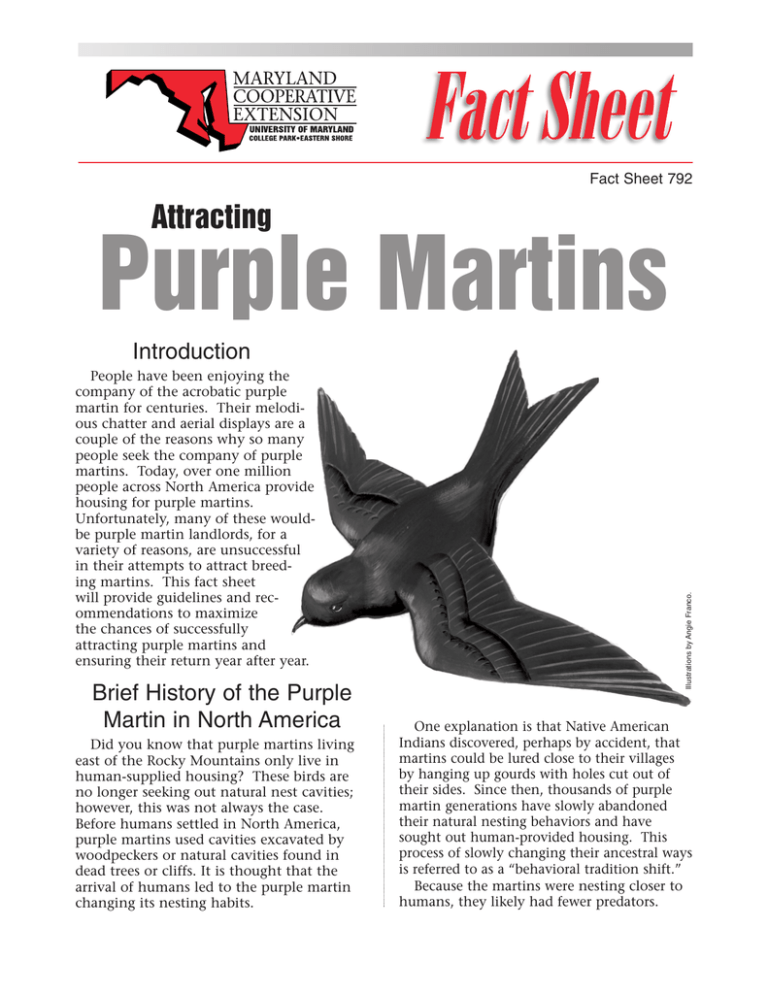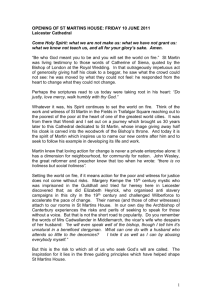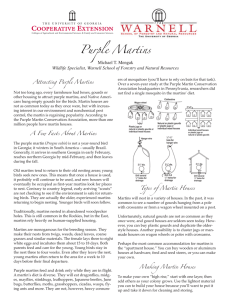Purple Martins Attracting Introduction Fact Sheet 792
advertisement

Fact Sheet 792 Attracting Purple Martins People have been enjoying the company of the acrobatic purple martin for centuries. Their melodious chatter and aerial displays are a couple of the reasons why so many people seek the company of purple martins. Today, over one million people across North America provide housing for purple martins. Unfortunately, many of these wouldbe purple martin landlords, for a variety of reasons, are unsuccessful in their attempts to attract breeding martins. This fact sheet will provide guidelines and recommendations to maximize the chances of successfully attracting purple martins and ensuring their return year after year. Brief History of the Purple Martin in North America Did you know that purple martins living east of the Rocky Mountains only live in human-supplied housing? These birds are no longer seeking out natural nest cavities; however, this was not always the case. Before humans settled in North America, purple martins used cavities excavated by woodpeckers or natural cavities found in dead trees or cliffs. It is thought that the arrival of humans led to the purple martin changing its nesting habits. Illustrations by Angie Franco. Introduction One explanation is that Native American Indians discovered, perhaps by accident, that martins could be lured close to their villages by hanging up gourds with holes cut out of their sides. Since then, thousands of purple martin generations have slowly abandoned their natural nesting behaviors and have sought out human-provided housing. This process of slowly changing their ancestral ways is referred to as a “behavioral tradition shift.” Because the martins were nesting closer to humans, they likely had fewer predators. Also, the larger than normal nesting cavities allowed the martins to raise larger numbers of young. For these reasons, it would have been advantageous for the fledglings to seek out this type of housing the following season, upon returning from their wintering grounds. This arrangement is thought to have been beneficial for the people as well. Historical information from the 18th and 19th centuries suggests that martins may have acted as scarecrows by chasing vultures away from drying hides and meats and driving crows from corn fields. We see evidence of this relationship still occurring today. In many places across North America purple martin housing of various designs can be seen erected near lakes, bays, and swamps. Most of these houses are provided for martins with the thought that they will consume a large number of mosquitoes. Research suggests that purple martins eat very few mosquitoes, if any. One reason is that the martin is too large of a bird to waste its energy on small mosquitoes. For all those people who hoped martins would curb their mosquito problem, they should actually be providing habitat for bats because bats, not purple martins, consume large numbers of mosquitoes. For information regarding how to attract bats to your area, read Fact Sheet 791, “Got Bugs? Get Bats!” This is not to say all those purple martin houses should be taken down. On the contrary, purple martins provide people with viewing enjoyment and also eat many agricultural and garden insect pests. Many of the insects purple martins eat are well known pests such as stinkbugs, wasps, leafhoppers, cicadas, grasshoppers, horseflies, moths, and flying ants. Most of these insects may pose a threat to crops or gardens and the others may prove to be a nuisance to backyard gatherings. trees versus a forested landscape. For this reason, people who live in areas with large open flyways such as wide open lawns, fields or pastures, ponds or lakes, are much more likely to attract martins. People fail to attract martins for many reasons, but the main reason is that tall trees are too close to the martin housing or the yard is too enclosed. As shown in Figure 1, purple martins require a minimum of 40' of clear space around the housing. This area should be devoid of trees, and shrubs or vines should not be allowed to grow up under the housing. Also, martins like to perch on wires, but wires should not be attached to the housing and housing should not be placed too close to over head wires to prevent squirrels from easily gaining access. Even though purple martins prefer to be in an open area, they do not like to be located too far from humans. As mentioned earlier, they associate people with relative protection from predators. Many purple martin predators such as raccoons, snakes, hawks, and owls are not normally found close to human housing. For these reasons, it is recommended that martin housing be placed no farther than 120' away from human housing (Figure 1). Martins that nest within this zone have a greater likelihood of successfully raising young. Also, if the housing can easily be seen, the martin landlord is more likely to witness and repel predators. As seen in Figure 1, an excellent place for purple martin housing is on a dock or pier. The other requirements still hold true in this instance. Purple martin housing works best when 10 to 20 feet in the air. Monitoring and maintenance are keys to successfully attracting and keeping martins, so your housing should be easily reached by a ladder or lowered for periodic nest checks and cleaning (this will be discussed in more depth in following sections). The Purple Martin Landscape Purple Martin Housing Options Purple martins are aerial insectivores which means they eat insects while in flight. Obviously it is easier for a purple martin to catch flying insects in an area that has few Cavity nesting birds in general will nest in a wide variety of houses if the hole and compartment sizes are compatible with their needs. The purple martin is no excep- The Purple Martin Myth 2 PURPLE MARTIN LANE TREES 40' MINIMUM 30' MIN. MARTIN HOUSING 120' MAX. 40' MINIMUM TREES TREES MARTIN HOUSING 30' MIN. 120' MAX. BOAT DOCK WATER TREES Figure 1. Ideal purple martin housing locations. 3 PURPLE MARTIN LANE WATER tion to this fact. Martin housing comes in a wide variety of shapes, sizes, materials, and colors. Fortunately, the Purple Martin Conservation Association has engaged in many years of research that gives us clues as to which types of housing are the most productive for martins. One of the most important requirements of purple martin housing is the necessity of raising and lowering the houses. If housing is simply erected and forgotten about, disaster will likely occur. Other species, especially non-native species, may take up residence in your martin housing and may be very hard to manage. Housing placed on a retractable or telescoping pole is optimal for monitoring and maintenance of the housing. Regardless of the pole design, easy access to your martin housing is imperative. James Hill, founder of the Purple Martin Conservation Association, conducted a study of 15 years of data collected on 2,729 active purple martin nests. The data that were analyzed looked at three different types of housing including wooden houses, natural gourds, and aluminum houses. Gourds were clearly the most productive in larger clutch size and number of fledglings. Second were wooden houses and the least productive type of housing was aluminum. Differences in productivity of the different housing are probably best explained by the size of the individual compartments in each type of housing. When providing housing for purple martins, we should not overlook the size of the housing compartment. Martins will be more productive in larger housing compartments, regardless of the overall housing design. In the study mentioned above, the gourds had the largest amount of space and the aluminum houses on average had the smallest 1-316" amount of space. Cavity nesting birds in general prefer larger nest compartments over smaller, when given the choice. Female cavity nesting birds often adjust the size of their clutch depending upon the size of their nest cavity. Often, the larger the nest cavity, the larger the clutch of eggs. These findings also hold true for purple martins. Regardless of the housing design, the floor dimensions for each compartment should be a minimum of 6"x6". Larger compartments (7"x12") are preferred by the martins and also provide increased shelter and protection from rain and predators. The height of the nesting compartment can be 6" to 7". Large compartments are preferred not only by martins but European starlings as well. In order to prevent starlings from nesting in martin housing, different shaped entrance holes can be provided (Figure 2). Entrance holes should be placed 1" above the floor. The preferred entrance hole size is 21⁄8", although martins will accept holes from 17⁄8" to 21⁄4." When purchasing or constructing martin housing, other amenities such as ventilation and drainage should be considered. Each compartment should have drain holes that will also aid in ventilation. If your martin house has not been successful, check the dimensions. If the dimensions are not correct, try modifying it to proper specifications. One modification that can be made is by removing compartment dividers to double the size of the compartments. In addition, porch dividers can be added to help keep males from claiming more than one compartment and to prevent nestlings from wandering to other compartments where they can get lost and die or steal food from younger nestlings, causing them to starve. What color should purple martin housing be? White seems to be the best color for a couple of reasons. First, it is thought that the hole opening contrasts the best against a white colored exterior. This contrast makes the entrance holes easier to spot while martins are flying by looking for potential nesting sites. Also, white houses do not get too hot in the middle of the summer, thus preventing nestlings from overheating. The latest invention in purple martin housing is the SuperGourd, a synthetic, extra-large gourd that has a nest inspection/clean-out 3" circle Figure 2. Starling Resistant Entrance Hole 4 access port on the side. The SuperGourd’s one-piece body has no seams, so no rain will leak in, and six 1⁄4-inch drain holes provide a rapid exit for any rain that blows in through the entrance hole. The SuperGourds can be easily mounted on a variety of poles or can be purchased with a telescoping pole and readymade mounting arms. When Should I Open My Housing in the Spring? The time to open your housing depends on whether or not you’ve had martins in the past. The first martins arrive in Maryland in mid to late March. Landlords that have previously had nesting martins can open their housing at this time. However, if you are a new landlord trying to attract martins for the first time, this would be four to five weeks too early to open your housing! The reason that previously successful landlords can start when the birds arrive is that the birds are what we call “site-faithful.” Adult martins exhibit a behavior known as site fidelity, meaning once they have bred successfully in a location they will return to breed in that same place year after year as long as the housing is available and properly maintained. Site fidelity means that the martins will return to your housing every year and will actually wait around for you to open it up. In fact, if you wish, you can leave the entrance holes on your house closed up until the martins return and land on the housing. This can help prevent nest site competitors from becoming established and can save you a lot of work pulling out starling and house sparrow nests. While the site fidelity of adult martins is strong, they probably won’t wait more than two to three weeks for their housing to be opened up, so be sure to open the housing as soon as the birds arrive and start landing. Yearling martins, the ones that you can hope to attract as a new landlord, do not arrive until four to five weeks after the first birds are seen in your area. If you have never attracted martins, do not open your housing until four to five weeks after the first martins arrive. If you have not had breeding martins in the past and you open your housing too early, you invite instant occupation by competing species. These species will prevent the housing from being occupied by martins and it will be very difficult to eliminate them once they become established. In contrast to the information above for adult martins, new landlords hoping to attract martins to unoccupied housing should never leave entrance holes plugged until the martins arrive. Yearling martins looking for new housing need to see open entrance holes in order to recognize a potential breeding site. If other species are trying to nest in the housing, a minimum of a few compartments should be left open on each side of the house to attract the attention of passing martins. How Do I Attract and Keep a Martin Colony? The two keys to attracting and keeping a successful martin colony are monitoring and maintenance. Martins are dependent on human-provided housing and they can be greatly aided by human management. Don’t be afraid to engage in “hands-on” management of your martin colony. Data suggest that active and involved owners can increase the success of their colonies by almost two times and certainly reduce the risk of suddenly losing an entire colony. 5 Walk under your housing daily, paying careful attention to items dropped on the ground. These dropped items can provide clues to what is happening in your housing units. Particularly look for signs of predation such as dead nestlings, plucked feathers, wings, or owl feathers. Early detection of a predator problem can save you from losing an entire colony, if dealt with promptly. If you find a live nestling that has fledged prematurely you can use the data from your weekly nest checks (see below) to return the nestling to its proper compartment. Far from causing martins to abandon a nest-site, weekly nest checks can greatly improve the success of your martin colony. Ideally during the egg-laying stage you should check the nests every four to five days. This regular nest check will allow you to determine the clutch-initiation date and therefore expected dates of hatching and fledging. After egg laying, check the nests every five to seven days unless your daily walk-unders indicate a reason to be concerned (see above). Number each of the compartments and keep careful records of each daily walk-under and weekly nest check. Keeping careful records not only allows you to understand the dynamics of your martin colony, but can also help you detect predation problems, return young to the proper nest, and determine whether missing young have fledged or died for some reason. During nest checks you should be on the look out for potential problems and remove from the nests any nonnative nest-site competitors such as starlings or house sparrows. their martin colony. There are two basic types of nest-site competitors, native species and non-native species. If desirable native species (such as tree swallows, eastern bluebirds, or house wrens) try to take over your empty martin housing, temporarily plug all the holes and provide appropriate single-unit housing elsewhere on your property. Reopen your martin housing only after the other species has accepted the alternate housing. Non-native species such as starlings and house sparrows represent a significant threat to martins and other native species. Nesting starlings and house sparrows will prevent yearling martins from choosing your new housing and if allowed to occupy existing martin colonies, will fill nesting compartments, break martin eggs, kill nestlings and even adult martins. Allowing these nonnative species to invade existing colonies will lead to greatly decreased colony success and possibly colony abandonment or loss through attrition. Steps to Control Non-Native Birds 1. Starlings and house sparrows should be managed by a repeated lowering of the house for nest tear-outs (martin eggs are white, while starling eggs are blue and house sparrow eggs are speckled brown). 2. Starlings and house sparrows may be trapped or shot (legal for these nonnative species). 3. Starlings can be further excluded by using housing with starling resistant entrance holes (SREH’s, see Figure 2), which are accepted by martins but normally not by starlings. SREH’s are particularly recommended for housing with the larger 7” x 12” compartments, which are more attractive to starlings. 4. You can also minimize starling and house sparrow problems by storing your martin housing inside over the winter and avoiding opening it too early in the spring (see “When Should I Open My Housing in the Spring?” above). Some Common Management Concerns Below are some common management concerns that martin landlords must deal with. These recommendations apply not only for current martin landlords, but prospective landlords should also take them into account when attempting to start a new colony. Nest-site competitors: The success of a martin colony relies on active control of nest-site competitors. Successful landlords with martins who allow their housing to become overrun with aggressive nest-site competitors, such as starlings and house sparrows, can lose Predation: Martin housing is susceptible to a whole array of aerial and climbing 6 Sevin®) is controversial and should definitely be avoided when techniques such as the replacement of nesting material and the use of DE are effective. Cleaning your housing: Keep your housing in good repair. Store it inside during the winter to minimize weathering and to prevent undesirable species from taking up residence. Before storing your housing, remove the nests and scrub the housing with a 10percent bleach solution. Rinse and allow the house to air dry before storing it permanently for the winter. Orienting housing after a nest check: After each nest check, great care should be taken to return the housing unit to the same height and orientation. Purple martins recognize their nesting compartment by its compass orientation, height, and relative position. If you fail to return the housing to its original position, adult martins will enter the wrong cavities. Havoc ensues and can eventually lead to many young and possibly adults dying and the permanent abandonment of the colony. Use alignment marks on the house and poles to ensure that the house is returned to the same height and oriented in the same compass direction as before the nest check. Providing extra housing and changing housing: Ultimately you should strive to cultivate a sustainable colony of martins. This means providing at least 24 to 30 total housing compartments and trying to build a colony of at least 12 to 15 breeding pairs. Having at least two different housing units also reduces the risk of a disastrous event eliminating your entire colony. Never suddenly replace your housing from one year to the next. Housing should be replaced over a two year period by erecting the new housing adjacent to the old housing and ensuring that at least some martins use it. Once martins have nested in the new housing do not move it to the site of the old housing, either eliminate the old housing or replace it with new housing. predators including raccoons, squirrels, snakes, hawks, owls, and crows. One successful nest predator could wipe out your entire colony or cause the abandonment of your site. Do not attach wires to your martin housing, especially if they lead to trees, buildings, or the ground. Climbing predators such as squirrels can use these wires to access your colony. All poles (whether wood or metal) should be equipped with baffles or pole guards to prevent climbing animals from using them to raid your colony. Even a rat snake can climb an unprotected pole and destroy an entire colony. Here are two ways to deter aerial predators. 1. To guard against aerial predators, martin housing should have compartments that are at least 6" x 6", but preferably 7" x 12". Adults and young may be able to avoid the reach of predators in compartments that are 12" deep. 2. You can also design or purchase a house that includes internal predator baffles or you can attach owl guards (available commercially) to the outside of your housing. Owl guards are wire cages that you attach to the outside of your martin housing like a protective birdcage. These owl guards should also help if hawks or crows are raiding your housing. Nest parasites and pesticides: Insects such as blackflies, blowflies, nest mites, fleas, and mosquitoes can become so prevalent inside the nesting compartment that they lead to reduced reproductive success or even in extreme cases total nesting failure and abandonment of the colony. Nesting material should be removed and replaced on the second and fourth nest checks after hatching or as often as needed due to parasite loads. Nests should be replaced with a 1" to 2" bed of soft wood shavings, dried grass clippings, or dried pine needles. Make a shallow bowl in the material and place the nestlings back in the nest. The application of freshwater diatomaceous earth (DE) underneath the nest is also highly effective and can be used once the nestlings are seven to 10 days old. The DE scratches the carapace of insect parasites causing moisture loss and death, but is safe for both humans and birds. The use of insecticides in the nesting cavity (such as References Information was adapted from the following Purple Martin Conservation Association publications: 7 The PMCA’s Best Martin Management Tips: Purple Martin Update 8(1), 1997, p.10. Attracting & Managing Purple Martins: 1995 PMCA. Ten Reasons Why People Fail to Attract Purple Martins: Purple Martin Update 2(3), 1990, p. 28 Twelve Reasons Why People Lose Their Purple Martins: Purple Martin Update 2(4), 1990, p. 28. Additional Resources Purple Martin Conservation Association Edinboro University of Pennsylvania Edinboro, PA, 16444 Phone: (814) 734-4420 Fax: (814) 734-5803 Email: pmca@edinboro.edu Web: www.purplemartin.org Standards for Purple Martin Housing: 1995 PMCA. Helpful Hints for Martin Landlords from the PMCA: 1995 PMCA. Figures were reproduced with permission from PMCA. Attracting Purple Martin by Reviewers M. Allan Daly Maryland Cooperative Extension Jonathan Kays Natural Resources Specialist Maryland Cooperative Extension Elijah Goodwin Organismic and Evolutionary Biology University of Massachusetts Robert Tjaden Natural Resources Specialist Maryland Cooperative Extension Dr. Don Kroodsma Biology Department University of Massachusetts Issued in furtherance of Cooperative Extension work, acts of May 8 and June 30, 1914, in cooperation with the U.S. Department of Agriculture, University of Maryland, College Park, and local governments. Thomas A. Fretz, Director of Maryland Cooperative Extension, University of Maryland. The University of Maryland is equal opportunity. The University’s policies, programs, and activities are in conformance with pertinent Federal and State laws and regulations on nondiscrimination regarding race, color, religion, age, national origin, sex, and disability. Inquiries regarding compliance with Title VI of the Civil Rights Act of 1964, as amended; Title IX of the Educational Amendments; Section 504 of the Rehabilitation Act of 1973; and the Americans With Disabilities Act of 1990; or related legal requirements should be directed to the Director of Personnel/Human Relations, Office of the Dean, College of Agriculture and Natural Resources, Symons Hall, College Park, MD 20742. P2002




